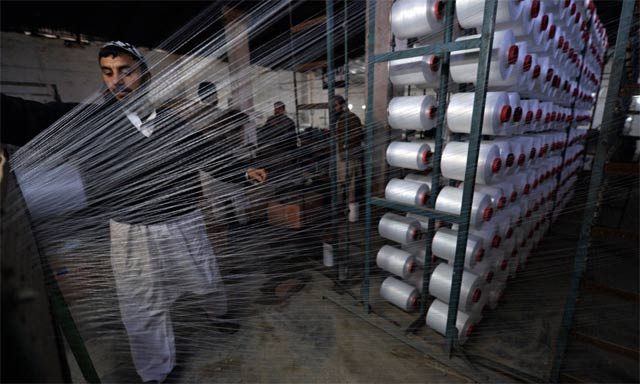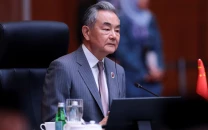Textile industry in its worst patch in history
Experts say gap between Pakistan and regional competitors widening

Experts say gap between Pakistan and regional competitors widening. PHOTO: AFP
The gap between Pakistan and its regional competitors has widened so much that now it looks unlikely that the country will ever catch up. The situation started deteriorating a decade ago but the stark disparity in exports became much more visible in the last five years.
Value-added textile: Industry fears further drop in exports
The story of Pakistan’s textile sector is not different from other major export-oriented industries of the country. The only difference is its sheer size in the country’s total exports that allows it to remain in the limelight. Other than securing the Generalised Scheme of Preferences (GSP) Plus status in the European Union (EU), textile exporters say this government has not done anything noticeable for the industry.
“The major difference is the attitude of our government and the governments of regional countries. The response time in Pakistan is too slow,” commented Ziad Bashir, Executive Director of Gul Ahmed Textile Mills, one of the country’s largest composite textile mills.
There is not a single major reason why Pakistan is lagging dramatically behind regional competitors. Problems like security challenges, energy shortages, high interest rates, lack of policy implementation and high utility prices have all contributed equally to the decline in textile exports, he added.
Manufacturers gear up for Chinese interest
“Had the government failed in securing the GSP Plus status, textile exports would have been in a much worse situation,” said Bashir.
Pakistan got the GSP Plus facility in December 2013 that allowed it to export its products to the EU on reduced or zero duty.
Regional comparison
According to the World Trade Organisation (WTO), world trade in textiles and clothing increased to $766 billion in 2013 from $454 billion in 2004, a significant increase of 69% despite the fact that the world experienced one of the worst financial crises in 2008-09.
Pakistan’s textile export share in the global market decreased from 2.2% in 2006 to just 1.8% in 2013. During the same period, Bangladesh’s share jumped from 1.9% to 3.3%, China’s share increased from 27% to 37% and India’s share improved from 3.4% to 4.7%, according to data compiled by the All Pakistan Textile Mills Association (Aptma).
Textile sector dreading gas suspension
Total exports of Pakistan in fiscal year 2014-15 were $23.6 billion, down 4.8% from $24.8 billion in fiscal year 2010-11. Similarly, textile exports have been hovering around $13 billion for the last five years.
This shows a practical breakdown of Pakistan’s export-based industries, including the textile industry that contributes over 50% to total exports.
Pakistan Apparel Forum Chairman Jawed Bilwani said he is certain textile exports will drop further. “The government knows everything about the international and domestic challenges of the textile industry and yet it is not doing anything.”
Textile industry: Think tank outlines factors hitting competitiveness
Pakistan is facing numerous economic problems but the prime minister has just met the exporters after assuming the office two and a half years ago, Bilwani said, adding this shows how serious the government is about arresting the dwindling exports.
Global impact
The economic slowdown in Europe and North America – the two most important textile markets for Pakistan, India, Bangladesh and Sri Lanka – has affected all the textile exporting nations of the region. However, the worst hit is Pakistan, indicating it has its own domestic problems that are contributing to low exports.
“It is not lack of innovation; it is the cost of doing business that has resulted in the decline in exports. Pakistan lagged behind in the region mainly because of its own domestic problems,” Aptma Chairman Tariq Saud said when asked about the decline in textile exports in the last decade.
We represent the entire textile industry: APTMA
The cost of gas for the industry has jumped to $6.7 per million British thermal units (mmbtu) mainly due to the imposition of Gas Infrastructure Development Cess (GIDC). Gas price in India is $4.2 per mmbtu, $3.1 in Bangladesh and $4.2 in Vietnam.
Pakistan’s electricity tariffs are also highest in the region. Average electricity prices in regional countries are in the range of 6-9 cents, but the price is 14.5 cents per unit in Pakistan, said Saud.
The writer is a staff correspondent
Published in The Express Tribune, November 30th, 2015.
Like Business on Facebook, follow @TribuneBiz on Twitter to stay informed and join in the conversation.



















COMMENTS
Comments are moderated and generally will be posted if they are on-topic and not abusive.
For more information, please see our Comments FAQ